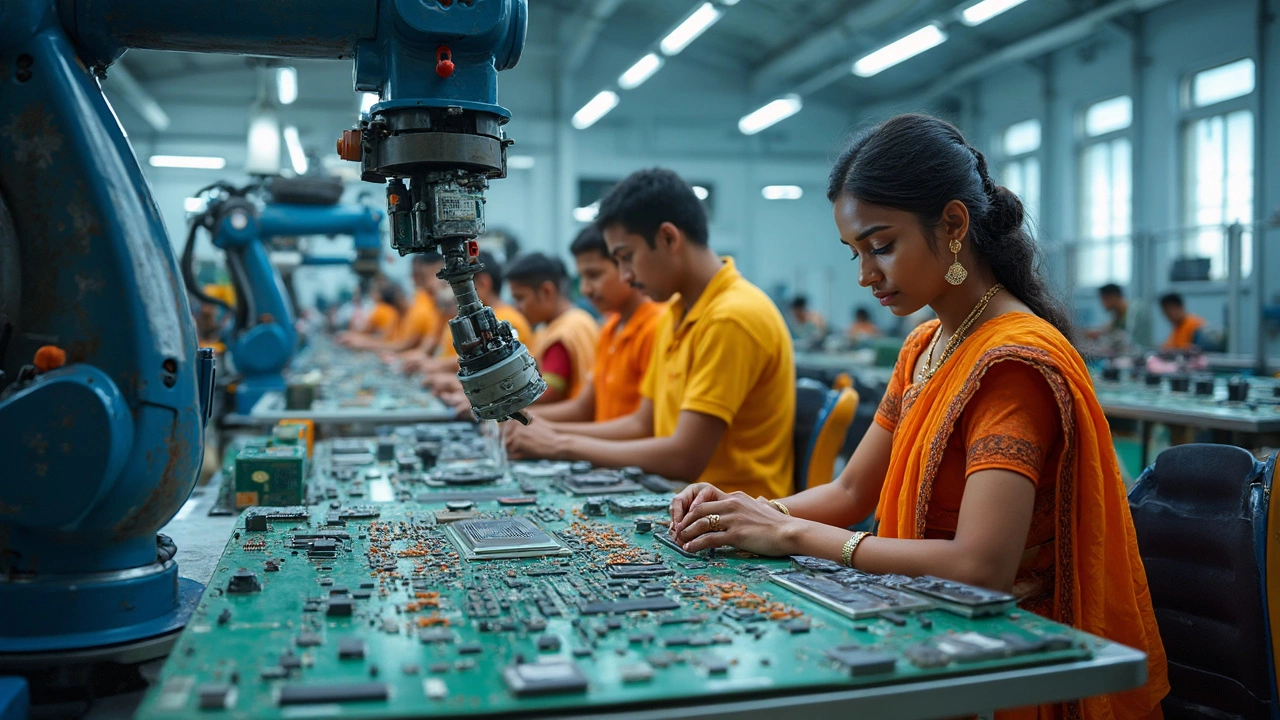China's grip on electronics manufacturing isn’t as iron-clad as it used to be. Right now, you’ll find factories in Tamil Nadu and Uttar Pradesh buzzing with activity that once belonged almost exclusively to the Pearl River Delta. India is throwing its hat in the ring, and it's not pulling any punches. Just a decade ago, anyone talking about India as an electronics giant would have sounded like a dreamer. But look at what’s changed—India’s electronics exports crossed $29 billion in the 2023-24 financial year, up from just $6 billion eight years ago. That’s not just a surge. That’s a thunderclap in the middle of a muggy Indian summer. What’s behind this blitz? It’s a heady cocktail of government policies, global supply chain shifts, and a homegrown appetite for gadgets that refuses to slow down.
From Importer to Export Powerhouse: The Transformation Story
The electronics story in India used to be pretty plain. For years, the country was mostly an importer—phones assembled in Shenzhen, laptops with stickers scraped off somewhere in Hong Kong, and TVs that arrived sealed in tape from Vietnam. Jump to 2025, and you’ll find a different scene. Apple, Samsung, Xiaomi—they’re not just watching India; they’re betting big on making gadgets inside Indian borders. In fact, India is now the world's second-largest mobile phone manufacturer, pumping out over 3 billion units in 2024. That’s a wild leap, fueled by investment, a trained workforce, and something else: policy muscle.
What turned the tide? The Production Linked Incentive (PLI) scheme in 2020 changed the game. The government hurled cash at manufacturers—promising payouts tied to performance. The goal? Get India making more, not just buying. If you look at the data, mobile phone exports hit around $16.5 billion in 2023-24 alone. And it’s not just handsets—everything from LEDs to smartwatches to audio equipment is now stamped ‘Made in India’ and shipped to more than 190 countries.
Of course, the ride hasn’t been smooth. Spotty infrastructure, red tape, and gaps in the supply chain have been stubborn thorns. But as factories turn out more phones and more jobs, even the big dogs on Wall Street and in Silicon Valley are starting to pay attention. Here’s the thing: this isn’t just a big-city phenomenon. You’ll find electronics clusters in places like Sriperumbudur, Noida, and Tirupati. The effect? People are staying in their home towns, skipping the metro rush, and working in high-tech jobs where they once might have farmed or migrated. It’s a rare win-win.
Why the World Is Eyeing Indian Electronics
It’s not just about serving India's huge population, though that would be reason enough. Geopolitical winds are shifting, and the world’s biggest brands want to spread their bets beyond China. Remember when the pandemic shut down half a dozen ports in Guangzhou? CEOs everywhere swore never to have all their eggs in one basket again. India—giant, English-savvy, and diving headlong into digitization—suddenly looked way more appealing.
Foxconn, the Taiwanese juggernaut famous for assembling iPhones, poured $1.6 billion into expanding factories in India last year. Pegatron and Wistron followed suit. And it’s not just assembly. Semi-conductor fabrication—a supply chain holy grail—is tiptoeing into India thanks to partnerships with big names like Micron and Tata. Local brands aren’t resting either. Companies like Dixon Technologies and Lava are rolling out devices at scale, some even white-labeling for global players. The hunt for homegrown component ecosystems is on. India wants to do more than just slap things together; it wants to own innovation, IP, and the hottest tech on the market.
There are teething troubles, for sure. Chipmaking factories don’t pop up overnight. There are still painful gaps—especially in semiconductor design and raw materials sourcing. Logistics is a work in progress. But things are moving fast. India ranks third in the world for smartphone manufacturing capability, just behind China and Vietnam, and aims to grab almost 10% of the global electronics manufacturing market by 2026.

Under the Hood: How Make in India Turbocharged the Sector
If there’s one slogan you can’t escape in Indian boardrooms, it’s “Make in India.” The government’s flagship initiative didn’t just throw up posters or hold summits. It handed real incentives to manufacturers, streamlined clearances, and worked with states to build modern industrial parks. Suddenly, a global CEO could come to India and see ready plug-and-play infrastructure. Factories running 24/7, skilled workers on tap, tax breaks—what’s not to like? The numbers don’t lie. Just peek at this table:
| Year | Electronics Exports ($ billion) | Mobile Phone Production (million units) |
|---|---|---|
| 2016 | 6.1 | 60 |
| 2018 | 11.3 | 130 |
| 2022 | 24.6 | 310 |
| 2024 | 29.2 | 330 |
States like Uttar Pradesh and Tamil Nadu raced ahead, setting up electronics clusters in record time. College students flocking to these hubs aren’t just looking for an assembly line job anymore. There’s R&D, there’s product design, and there are real chances for startups. Experts point to the Digital India push and the Smart Cities Mission as major enablers. As more government services go online and as everyone from local shops to farmers uses fintech tools, demand for affordable, durable gadgets soars. This “rising tide” is dragging a whole fleet of Indian and global tech companies along for the ride. According to the India Electronics and Semiconductor Association, "The next decade will see India not just assemble, but create cutting-edge hardware solutions for the world."
Challenges Behind the Scenes: What’s Holding India Back?
For every new iPhone rolling off a Noida assembly line, there’s a set of headaches waiting backstage. The scariest? India’s limited local supply of key electronic components. Around 70% of smartphone parts are still imported, mostly from China and Taiwan. This dependence means any global crisis—a port blockade, diplomatic spat, or raw materials shortage—could seriously cramp India’s growth plans.
Then you’ve got the talent crunch. Yes, there are millions of young engineers, but deep expertise in semiconductor design, embedded systems, and cleanroom manufacturing is rare. Only a handful of Indian universities offer world-class chip design or nanoelectronics programs. This skills gap means global giants still run the show for cutting-edge tech.
There’s also regulatory clutter. “Single-window clearance” sounds great on paper, but in reality, paperwork still moves at a crawl in some states. Transport costs spike when you hit patchy rural roads or get caught in last-mile regulatory traps. And don’t even start on electricity—power outages still plague several industrial zones.
One dark horse challenge? The environment. Large-scale electronics manufacturing can ravage water tables and air quality if not policed. Activists and watchdogs want stricter rules, and global buyers are demanding cleaner supply chains. To rise up, India’s electronics industry must master not just scale, but sustainability.
“For India to become a true global leader in electronics, we must invest in deep R&D, robust supply chains, and responsible manufacturing—fast,” says Dr. V. Kamakoti, Director, IIT Madras.

The Next Wave: What’s Coming for Indian Electronics?
The momentum is clear, but what’s next for this industry? Watch out for chip manufacturing: the first big semiconductor fab is scheduled to go online in 2026, thanks to a $2.75 billion tie-up between Tata Group and key global players. AI-powered devices, smart appliances, electric vehicle components—these are growth engines waiting to be unleashed. As 5G and IoT take off, expect to see a boom in homegrown startups building not just for India, but for the world.
Tips for entrepreneurs? Don't just look at mobile phones. Wearables, robotics kits for schools, medical electronics—these areas are ripe for disruption. If you’re a young engineer, invest in skills like chip design, PCB layout, firmware, and hardware security. Partnerships with global brands are a smart move, but don’t ignore India’s giant domestic market—rural India is hungry for affordable, tough-as-nails gadgets that last. If you're into sustainability, solar-powered gadgets and e-waste recycling businesses are getting a lot of attention from investors.
If there’s one big headline, it’s this: the India electronics industry is not just riding a wave—it’s helping make the wave. While it won’t replace China overnight, the shift is real, and it’s got a uniquely Indian flavor. Think frugal innovation, huge diversity, and a restless, youthful drive. The electronics revolution is happening, not in some far-off factory, but maybe right in your city, just down the block.





